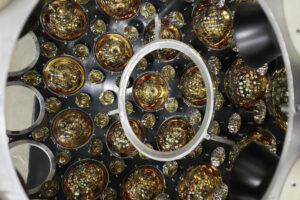Just over 100 years ago, physicists stumbled upon an elementary particle that could answer questions about the origin of the universe. Elusive and almost nonexistent, neutrinos may be the solution to understanding everything from the Big Bang to the inner workings of the atomic nucleus — and UNC physicist Julieta Gruszko can’t stop chasing them.
A sphere covered in nodes and black wires sits in the middle of a large white room. It’s about the size of a jungle gym, and each node is a long cylinder that can detect light and multiply its output by 100 million times. While this sounds like a piece of alien technology from a science-fiction novel, it is quite real and does something incredible: It measures energy. More specifically, it measures elementary particles called neutrinos. If you want to get technical, it measures a lack of neutrinos.
Neutrinos are everywhere. Most are created from nuclear reactions that occur inside the sun and stars; others come from radioactive decay that heats Earth’s interior; and some form inside humanmade nuclear reactors. About 10,000 trillion of them will pass through you by the time you’re done reading this sentence. They are neutrally charged, they move at the speed of light, and they have almost no mass — a recent, Nobel Prize-winning discovery.
If there are so many of them, why does this device measure the absence of them?
Please follow the link for further information regarding Julieta Gruszko and her lab’s research The Invisible Chase | Endeavors (unc.edu)


